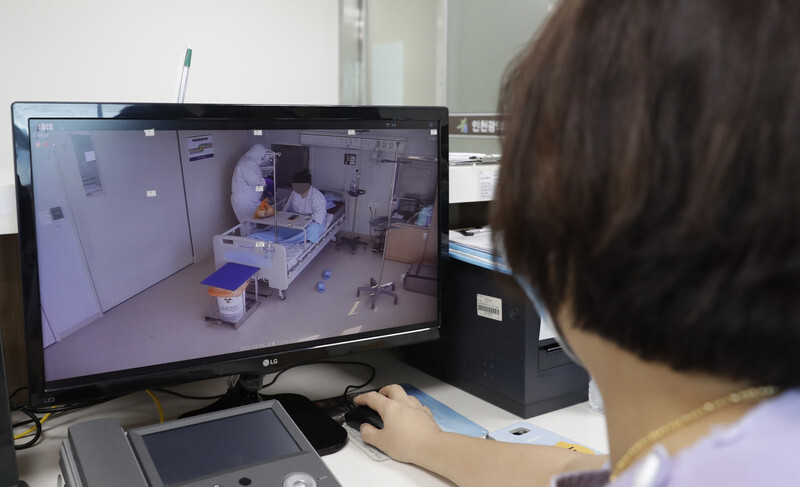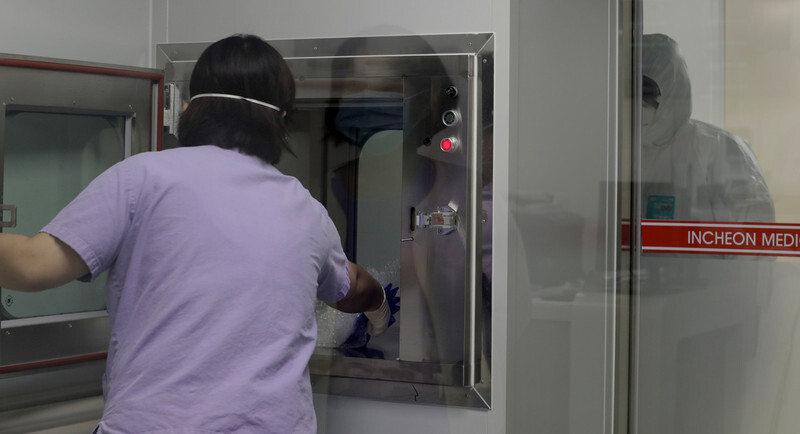hankyoreh
Links to other country sites 다른 나라 사이트 링크
[Reportage] A look at the treatment and quarantine procedures for a coronavirus patient

“Before you’re admitted, I’m just going to take your temperature.”
On Feb. 5, I visited Incheon Medical Center, where a 35-year-old Chinese woman (identified by the initial “A”) was hospitalized as the first patient in South Korea with a confirmed novel coronavirus diagnosis. As I entered, a staff member wearing a face mask approached me with a thermometer. The device showed a reading of “36.4 degrees [Celsius].” It fell within the normal range, but I was then asked, “Have you by any chance been in China recently?” It was a kind of independent “quarantine” effort for visitors. The same procedure was repeated on the sixth floor, which has negative pressure rooms that artificially reduce air pressure to prevent the virus from escaping.
That morning, one of the suspected patients was just going through discharge procedures at the center, which has seven negative pressure sickbeds. In addition to the one confirmed case, 18 other suspected patients had been hospitalized at Incheon Medical Center as of that day; all of them tested negative and were discharged. On a closed-circuit feed in the nurses’ station, A could be seen lying in bed looking at her mobile phone. Her condition had improved rapidly since the weekend before. Two gene amplification (PCR) tests administered on Feb. 1 and 2 had both shown negative results. For a patient to be declared recovered, they must test negative twice at 24-hour intervals after all symptoms have disappeared.
Dressed in an anti-contamination uniform reminiscent of a white spacesuit, a nurse went inside with a lunchbox. The patient sat up and prepared to eat. The nurse disinfected her hands in front of the room, measured the patient’s body temperature and blood pressure, and then disinfected her hands once again; only then was the lunchbox unpacked and given to the patient. The restaurant had prepared a Chinese menu out of consideration for patients unable to eat kimchi or other Korean food, I was told.
Kim Jin-yong, who has been responsible for A’s case and director of the center’s infectious disease division, also hurried to eat his own lunch. He only had around 15 minutes to eat, as he was scheduled for a video conference at 12:30 pm that day with physicians in charge of coronavirus patients at other hospitals to discuss whether to release A from isolation.
“In A’s case, respiratory difficulties emerged in the later period [of her hospitalization], and there was a danger period of about two to three days,” he explained.
“About a week after her hospitalization, we placed a canula [tube] in her nose to supply oxygen, increasing the amount from three to six liters,” he added.
“Just in case, we prepared a high-flow oxygenator that provides dozens of liters of oxygen each minute. Fortunately, [her condition] did not deteriorate to that extent.”

A was admitted on Jan. 19 after being detected by the airport quarantine network with a high temperature of 38.3 degrees. Since then, she has undergone treatment while isolated in Incheon Medical Center’s negative pressure section. On Jan. 18, a day before her arrival, A manifested symptoms including fever, chills, and muscle pain; she began exhibiting mild respiratory distress on Jan. 21, three days after first showing symptoms. Her oxygen saturation dropped to 91%. The same day, treatment began with antiviral medications used for human immunodeficiency virus (HIV) infections.
Her fever persisted for around 10 days. It reached a peak of 38.9 degrees on Jan. 24 -- the seventh day after her symptoms appeared -- before gradually subsiding. The respiratory distress symptoms began slowly improving around Jan. 31, the 14th day after symptoms appeared. Lung lesions that had been observed in computerized tomography (CT) scans also began shrinking around the same day. As of Feb. 5, A’s oxygen saturation screen showed a reading of 98%, indicating a return to normal levels.
“In contrast with the pattern for other viral pneumonias where symptoms like phlegm and hemoptysis [coughing up blood] are present early on and disappear, the characteristic [of novel coronavirus cases] is that there is only a cold symptom-like fever for the first five or six days, with pneumonia developing later on,” he explained.
“The first patient’s symptoms have appeared roughly moderate, while the other patients [still] appear to be manifesting cold-like symptoms.”
Patient’s hometown in Wuhan; unsure of when she’ll return to ChinaThat morning, Kim used a translation app to ask A when she was planning to return to China once she was released from isolation.
“My home city of Wuhan is currently sealed off, so I don’t know,” she replied. “I’ll have to consult the Chinese government.”
I asked Kim about their most memorable conversation, and he showed a screen capture of a message A had sent him.
“Thank you all so much for your cake. I feel so fortunate!” the message read.
A was released on Feb. 6. She reportedly plans to remain in South Korea for the time being. As she was being discharged, A shared a letter written in English to the physicians.
“In China, we have the phrase ‘yizhe renxin,’ which means that ‘those who heal have kind hearts.’ All of you have been even more than that to me,” she wrote.
By Park Da-hae, staff reporter, and Lee Jung-ha, Incheon correspondent
Please direct comments or questions to [english@hani.co.kr]

Editorial・opinion
![[Column] The state is back — but is it in business? [Column] The state is back — but is it in business?](https://flexible.img.hani.co.kr/flexible/normal/500/300/imgdb/original/2024/0506/8217149564092725.jpg) [Column] The state is back — but is it in business?
[Column] The state is back — but is it in business?![[Column] Life on our Trisolaris [Column] Life on our Trisolaris](https://flexible.img.hani.co.kr/flexible/normal/500/300/imgdb/original/2024/0505/4817148682278544.jpg) [Column] Life on our Trisolaris
[Column] Life on our Trisolaris- [Editorial] Penalties for airing allegations against Korea’s first lady endanger free press
- [Editorial] Yoon must halt procurement of SM-3 interceptor missiles
- [Guest essay] Maybe Korea’s rapid population decline is an opportunity, not a crisis
- [Column] Can Yoon steer diplomacy with Russia, China back on track?
- [Column] Season 2 of special prosecutor probe may be coming to Korea soon
- [Column] Park Geun-hye déjà vu in Yoon Suk-yeol
- [Editorial] New weight of N. Korea’s nuclear threats makes dialogue all the more urgent
- [Guest essay] The real reason Korea’s new right wants to dub Rhee a founding father
Most viewed articles
- 1Amid US-China clash, Korea must remember its failures in the 19th century, advises scholar
- 2[Column] The state is back — but is it in business?
- 360% of young Koreans see no need to have kids after marriage
- 4New sex-ed guidelines forbid teaching about homosexuality
- 5[Column] Life on our Trisolaris
- 6Presidential office warns of veto in response to opposition passing special counsel probe act
- 7Trump’s talk of flouting NATO promises sparks apprehension in Seoul
- 8[Reporter’s notebook] In Min’s world, she’s the artist — and NewJeans is her art
- 9[Guest essay] Maybe Korea’s rapid population decline is an opportunity, not a crisis
- 10Trump asks why US would defend Korea, hints at hiking Seoul’s defense cost burden